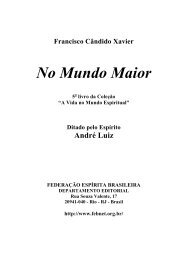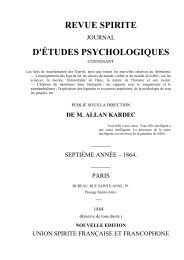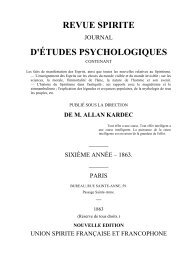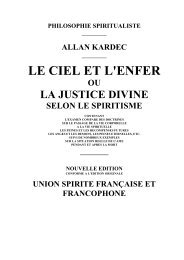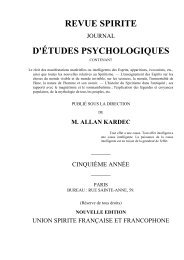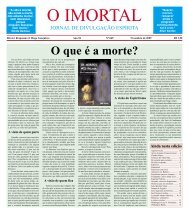PDF version - Geae
PDF version - Geae
PDF version - Geae
Create successful ePaper yourself
Turn your PDF publications into a flip-book with our unique Google optimized e-Paper software.
The law of the return of the soul to flesh is the law of attraction and affinity. When the spirit<br />
reincarnates it is attracted to a centre conforming to its tendencies, character, and degree of evolution. Souls<br />
incarnate by groups; they constitute spiritual families whose members are united by tender and powerful ties<br />
contracted during existences pursued in common. At times these spirits are separated from one another<br />
temporarily, and choose new localities to acquire new faculties. This explains the analogies and the differences<br />
which characterize members of one family, children and parents. It has been said that reincarnation ruins the<br />
idea of family, and confuses the situation occupied by parent and child, husband and wife, etc. It is quite the<br />
contrary. In the hypothesis of one life, spirits disperse after a brief existence, and frequently become strangers.<br />
According to orthodox creeds, souls after death are placed in two diverse situations conforming to their merits,<br />
and the ‘select’ are separated for ever from the ‘reprobates.’ As a result the ties of family are broken at death<br />
never to be united. While by rebirths, spirits unite anew, and pursue in common their peregrinations through<br />
the worlds, and their union becomes in this way more complete. Our spontaneous tenderness for certain people<br />
here is easily explained; we have already known them, and are but reconstructing old affections. How many<br />
lovers, how many husbands and wives are united by innumerable existences pursued together! Their love is<br />
indestructible - for love is the force of all forces, the supreme tie which nothing can break. The conditions of<br />
reincarnation are such that reciprocal situations are rarely changed. The advanced spirit in the liberty it has<br />
gained chooses the place where it will be reborn, while the inferior spirit is pushed by a mysterious force<br />
which it obeys instinctively. But all are protected, counseled, and sustained in the passage through space and<br />
earthly existence, more painful and difficult than death.<br />
The union of the soul to the body is effected through the means of the etheric form, of which we have<br />
spoken; by its subtle nature it serves as a tie between spirit and matter. The soul is attached to the germ by this<br />
plastic mediator which binds it more and more through the phases of progressive gestation and forms the<br />
physical body. Fibre by fibre, molecule by molecule, from conception to birth, the fusion operates slowly.<br />
Under the increasing flow of material elements and the force furnished by ancestors, the vibratory movements<br />
of the etheric body of the infant are reduced, while the soul faculties, the memory, and consciousness of other<br />
lives is annihilated. All the impressions of its celestial life and its long past are plunged in depths of<br />
unconsciousness. They will emerge again only at the hour of trance or of death, when the spirit regains the<br />
plenitude of its vibratory movements and elucidates the sleeping world of its memories. The role of the etheric<br />
double is large: it explains from birth to death all vital phenomena. Possessing in itself the ineffaceable traces<br />
of all states of being since its origin, it communicates the impression and the essential traits to the material<br />
germ. The key to embryonic phenomena is there during the period of gestation; the etheric body impregnates<br />
itself with the vital fluid, and materializes sufficiently to become the regulator of the energy and the support of<br />
the elements furnished by the progenitors.<br />
It is the invisible armature which sustains the human frame; thanks to it, individuality and memory are<br />
conserved in spite of the vicissitudes of the changing and mobile part of being. And it assures, too, the memory<br />
of the present existence, a chain of souvenirs from the cradle to the tomb, furnishing us with intimate certitude<br />
of identity.<br />
The incorporation of the soul is not spontaneous, but is gradually developed, and becomes complete<br />
but at birth. At this moment matter completely enfolds the spirit, which will vivify it in return by acquired<br />
faculties. Long will be the period of its development, during which the soul will apply itself to fashion a new<br />
envelope, and to make it an instrument capable of manifesting interior powers. But in this work the soul will<br />
be assisted by a spirit ordained as its guide, which watches over it and inspires and directs it during its long<br />
earthly pilgrimage.<br />
Each night during sleep, and often in the day during childhood, the soul disengages itself from the<br />
body and returns to space to gain new force, and returns to its sleeping body to take up its painful existence.<br />
Before resuming contact with matter and commencing a new career, the spirit, we have said, must chose the<br />
place where it will be reborn on earth. But this choice is limited, circumscribed, and determined by multiple<br />
causes. The former lives, its moral debts, its affections, its merits and demerits, the role it is fitted to play - all<br />
these elements intervene in the fixing of the life in preparation. They help to decide the race, the place, the<br />
family. The earthly souls we have loved attract us; the ties of the past are renewed in other alliances and<br />
friendships. The same places even exercise upon us their mysterious attraction, and it is rare when destiny does<br />
not lead us several times to the country where we have lived, loved, and suffered. Hate, too, is a force which<br />
66



